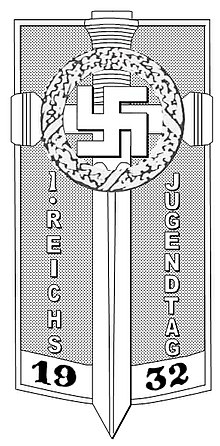Potsdam badge of the NSDAP
The Potsdam badge was a conference badge of the National Socialist German Workers' Party introduced in 1932 , which was issued on the occasion of the First Reich Youth Day in Potsdam from October 1st to 2nd, 1932 in two stages, bronze and silver . The bronze conference badge was given to spectators and the like, while the silver badge was given to active participants. The latter badges could also be worn with uniforms.
The Potsdam badge also counts as the other decorations of the Nazi Party in the Federal Republic of Germany as anti-constitutional propaganda . It is prohibited to make, wear or distribute them in public.
Design and manufacture
The design of the badge comes from Adolf Hitler himself. The production costs should be covered with the sale of the badges. The sole manufacturer of the badge was the Hoffstätter company in Bonn .
description
The badge is made of brass , bronzed or silver-plated and measures 48.5 mm from the upper pommel to the lower tip of the sword. Its width is 22.5 mm. The shape is that of an upright rectangular shield with a conical lower edge. It shows a vertically standing sword on a grained ground, the handles and tip of which protrude over the edge of the badge. In the middle of the handle you can see a laurel wreath, which encloses a swastika. The two letters N (left) and S can be read above . The edge of the sword is flanked on the left by the inscription: I. REICHS and on the right by the word: JUGENDTAG . The conclusion is a separated curved field with the year numbers of the event year 1932 , whereby the year numbers are separated by the sword edge. The back of the badge is smooth and shows, in addition to the manufacturer's name, a vertically soldered brooch pin.
Award numbers
70,000–115,000 Potsdam badges are likely to have been awarded.
literature
- Kurt-Gerhard Klietmann : German Awards. Volume 2: German Empire: 1871–1945 . The Order Collection, Berlin 1971.
See also
Web links
- Potsdam badge 1932 ehrenzeichen-orden.de

